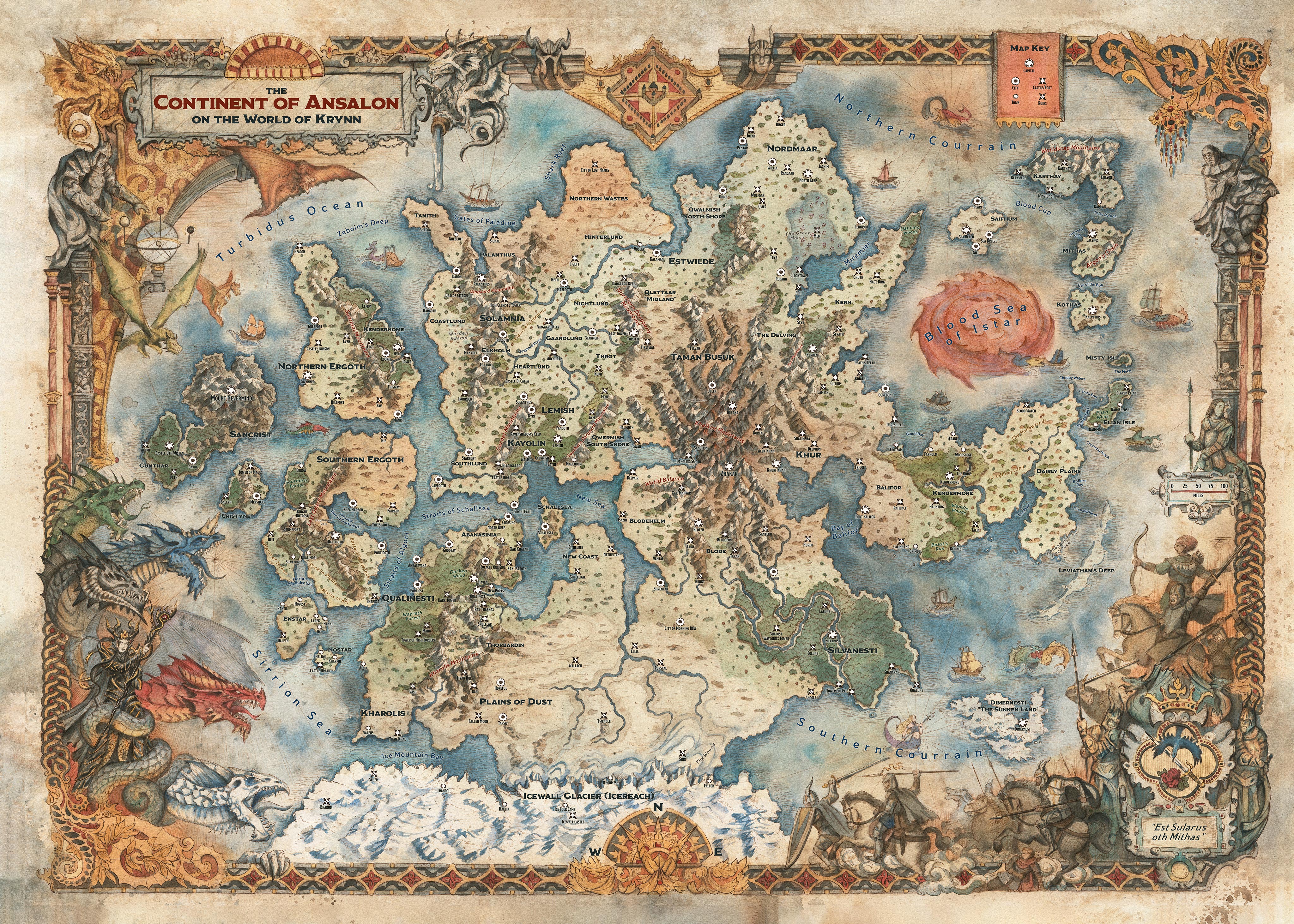Life in Ansalon
While Krynn holds many lands and cultures, the War of the Lance and adventures surrounding that conflict unfold on the continent of Ansalon. Here are a few details regarding everyday life there.
Languages
Across Ansalon, language is an expression of upbringing and exposure. Before the Cataclysm, Common served as a language of commerce under the empires of Ergoth, Solamnia, and Istar. After the Cataclysm, migrating refugees communicated using Common, and today it’s spoken in every corner of the continent. Nevertheless, the local languages of most lands still flourish, and Common is used primarily in markets and in dealings with travelers.
With the DM’s approval, players can exchange a language granted by their characters’ race for a different language from the Standard Languages of Ansalon table or the Rare Languages of Ansalon table.
| Standard Languages | Main Speakers | Script |
|---|---|---|
| Common | Trade language in Ansalon | Common |
| Abanasinian | Abanasinia | Common |
| Dwarvish | Abanasinia, Kayolin, Thoradin, Thorbardin | Dwarfish |
| Elvish | Qualinesti, Silvanesti, Southern Ergoth | Elvish |
| Ergot | Northern Ergoth | Common |
| Gnomish | Sancrist | Common |
| Kenderspeak | Goodlund, Hylo | Common |
| Kharolian | Plains of Dust, Tarsis | Common |
| Khur | Khur | Istarian |
| Nordmaarian | Nordmaar | Istarian |
| Solmanic | Sancrist, Solamnia | Common |
| Rare languages | Main Speakers | Script |
| Draconic | Dragons | Draconic |
| Goblin | Taman Busuk | Dwarvish |
| Istarian | Ancient Istarians | Istarian |
| Kothian | Minotaurs | Kothian |
| Nerakese | Neraka | Istarian |
| Ogre | Blode, Kern | Ogre |
| Primordial | Elementals | Primordial |
| Sylvan | Fey Creatures | Sylvan |
Calendar
| Month | Name |
|---|---|
| January | Newkolt |
| February | Deepkolt |
| March | Brookgreen |
| April | Yurthgreen |
| May | Fleurgreen |
| June | Holmswelt |
| July | Fierswelt |
| August | Paleswelt |
| September | Reapember |
| October | Gildember |
| November | Darkember |
| December | Frostkolt |
| Day | Name |
|---|---|
| Sunday | Linaras |
| Monday | Palast |
| Tuesday | Magetag |
| Wednesday | Kirinor |
| Thursday | Misham |
| Friday | Bakukal |
| Saturday | Bracha |
Currency
Since the Cataclysm, the harsh realities of daily survival leave little room for impracticality. For years after the devastation, steel’s value skyrocketed until it was valued as highly as gold, thanks to the difficulty of forging steel and its obvious practical applications. Similarly, bronze was valued on par with silver. While the value of steel and bronze has diminished to pre-Cataclysm standards, trade coins of bronze and steel remain in use across Ansalon.
| Coin | cp | bp/sp | gp/stl | pp |
|---|---|---|---|---|
| Copper (cp) | 1 | 1/10 | 1/100 | 1/1,000 |
| Bronze (bp) or Silver (sp) | 10 | 1 | 1/10 | 1/100 |
| Gold (gp) or Steel (stl) | 100 | 10 | 1 | 1/10 |
| Platinum (pp) | 1000 | 100 | 10 | 1 |
Organizations
Knights of Solamnia
King Solamnus sought above all to rule this new society justly. On the Isle of Sancrist, at a black granite stone in a secluded glade, he prayed to the gods for guidance. Three of the gods of good appeared to him: Paladine, god of justice and order; Kiri-Jolith, god of just warfare; and Habbakuk, god of nature, loyalty, and the elements. The three gods inspired three orders of knights that would guard the realm together as the Knights of Solamnia.
Mages of the High Sorcery
Predominantly composed of wizards—with a lesser number of sorcerers, warlocks, and other spellcasters—members are divided into three orders. Each order dedicates itself to virtues extolled by a god of magic and honors the moon its deity is associated with.
